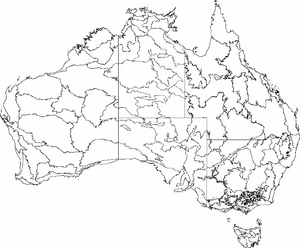Regions of Tasmania facts for kids
Tasmania, an island state in Australia, has many areas known by special names called regional names. A region is an area that shares similar features. These features can be natural, like the Furneaux Islands or the Central Highlands. They can also be cultural, like areas known for growing grapes (viticulture).
Different groups use different ways to divide Tasmania into regions. Often, these regions are called North West, West Coast, Southern, and East Coast by the media. In the 1960s, a book called the Atlas of Tasmania helped define these regions.
Contents
Local Councils
In Tasmania, local councils are the third level of government. They work after the national (federal) and state governments. These councils manage local areas, like cities and towns.
Tasmania has 29 local council areas. Each area has an elected council. These councils handle many tasks given to them by the Tasmanian Government.
The local council areas in Tasmania are grouped into six main regions:
- Central
- Hobart
- Launceston
- North-east
- North-west and west
- South-east
How Statistics Are Grouped
The Australian Bureau of Statistics (ABS) uses different regional groups to collect and share information. These groups are based on the Australian Standard Geographical Classification (AGSC).
The smallest area the ABS looks at is called a Census Collection District (CCD). These small areas combine to form Statistical Local Areas (SLAs). SLAs are often the same as local council areas.
The ABS also provides information for larger statistical groups:
- Statistical Divisions
- Statistical Regions
- Statistical Districts
Statistical Divisions
Statistical Divisions (SDs) are big areas used for looking at social, population, and economic information. Their borders are based on how people live and work.
Tasmania has five Statistical Divisions:
- Greater Hobart
- Southern
- Northern
- Mersey-Lyell
- Off-Shore Areas & Migratory (this includes islands and people who move around)
Statistical Regions
Statistical Regions (SRs) were created in 1986. They are used to study information about jobs and the workforce.
Tasmania has four Statistical Regions:
- Greater Hobart
- Southern
- Northern
- Mersey-Lyell
Statistical Districts
A Statistical District (SDist) is a city area outside of the capital city. It has a population of 25,000 or more. These districts are planned with future growth in mind. They don't always follow local council borders.
Tasmania has two Statistical Districts:
- Launceston
- Burnie-Devonport
Natural Regions
The Interim Biogeographic Regionalisation for Australia (IBRA) divides Australia into natural regions. These are called bioregions. There are 89 bioregions and 419 smaller subregions across Australia.
Each bioregion is a land area with similar natural environments and ecosystems. These regions and subregions can cross state borders.
Nine bioregions are found in all or part of Tasmania:
- Ben Lomond
- Furneaux
- King
- Tasmanian Central Highlands
- Tasmanian Northern Midlands
- Tasmanian Northern Slopes
- Tasmanian Southern Ranges
- Tasmanian South East
- Tasmanian West
Everyday Regional Names
People in Tasmania often use informal names for different parts of the state. These names help describe where places are.
| Informal divisions of Tasmania | ||
|---|---|---|
| Region name | Subregion name | Comments |
| Western | North West | This area is north of the Pieman River mouth and goes around to the Bass Strait. |
| South West | This area stretches from Cape Sorell in the west to either South Cape or South East Cape in the east. | |
| Southern | ||
| South East | This region goes from South East Cape in the southwest, north to Hobart and up to Wineglass Bay. | |
| Eastern | ||
| Midlands | This is an inland area, from north of Richmond in the south to Launceston in the north. | |
| North East | This area goes from Wineglass Bay in the south to the Bass Strait coast in the north. | |
| Northern | Central Highlands | This is the central part of Tasmania. It goes from Lake St Clair in the north to the lower River Derwent in the south east. |
| North West | This area stretches from the Bass Strait coast in the north to the Pieman River in the north west. | |
Regions for Specific Uses
Weather Forecasting
Since 2013, the Australian Bureau of Meteorology (BOM) has divided Tasmania into eleven land-based areas for weather forecasts. They also have nine coastal areas and five inshore areas for bays and channels.
- Land-based districts
|
|
- Coastal districts
|
|
Tourist Regions
Tourist regions are created to help promote different parts of Tasmania to visitors. Some of these regions are small parts of larger areas, while others combine different regions.
Common regions used for tourism include:
- Hobart
- Huon Valley and D'Entrecasteaux Channel (Southeast)
- Derwent Valley and Central Highlands
- Launceston and the Tamar Valley
- Midlands
- North East
- Devonport and Cradle Valley
- West Coast and Wilderness
As of 2015, Tourism Tasmania, a government group, divided the state into five regions on the mainland and two regions for the main islands in Bass Strait:
- East Coast
- Flinders Island
- Hobart and South
- King Island
- Launceston and North
- North West
- West Coast
Wine Regions
Tasmania also has specific regions known for growing grapes and making wine.
- Huon Valley - south of Hobart
- North West - south of Devonport
- Tamar Valley - along the valley north of Launceston
- Pipers River - on the Georgetown to Bridport road
- East Coast - between Bicheno in the north, and east of Sorell
- Coal River Valley - between Cambridge and north of Colebrook
- Derwent Valley - between Hamilton and Hobart
- Southern - between Kingston and Southport


